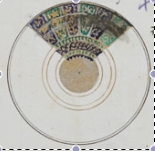This page deals with the skills required by the assistants Pitt-Rivers required to concentrate on artistic endeavours, the assistants who were employed principally for their artistic abilities. They had two functions: to provide illustrations for the private publications by Pitt-Rivers and to prepare the catalogue of the second collection.
Bowden [1991: 104 et seq.] states that Pitt-Rivers was very clear about the skills his assistants required: the most important was draughtsmanship. Pitt-Rivers himself undertook to teach them surveying. Harold Gray identified the Royal College of Arts training as an essential background for the draughtsmen though at least one (Peacock) was trained by the British Army to prepare drawings. Another (Waldo Johnson) had been trained at the RCA and was qualified to be an art master.
Pitt-Rivers seems to have asked for portfolios of work on which to judge candidates for the post of assistant. All known assistants were asked for this, he usually required drawings of 'antiquities'.
The assistants' artistic skills were most important when preparing the drawings for the catalogue and the publications. Although the catalogue drawings were coloured, by and large the publications drawings were in black and white. However, it is known that a few copies of the publications were hand-coloured by the assistants, though none of these volumes is known (at the present time) to be in public collections. [Mark Bowden, pers. comm.] Pitt-Rivers seems to have advertised for new assistants when he wanted them in various technical publications (like The Engineer) and via people like John Charles Lewis Sparkes, dealer and tutor at the Royal College of Arts.
Pitt-Rivers' requirements
In 1898, Pitt-Rivers clearly set out his requirements for his artistic assistants in a letter to John Sparkes who worked at the Royal College of Art. 'pen & ink line drawings & black & white wash-drawing (mezzotints)'. [L2076 S&SWM PR papers]
The Royal College of Art
which in the nineteenth century incorporated the National Art Training School. According to Gray [1905: xxvii], 'the staff always included at least one highly-certificated draughtsman from the Royal College of Art, South Kensington'. When Pitt-Rivers was dealing with it the College formed part of the Department of Science and Art which also administered South Kensington Museum.
The objective of the RCA at this time was:
the training of Art teachers of both sexes, of designers, and of Art workmen...The Royal College of Art is not intended to train painters of easel pictures. As the National Art Training School, it was originally intended to train designers for fabrics, &c., to train craftsmen rather than artists. ['Report on the Royal College of Art', (1897) quoted here]
In 1894 free admission was given to some students, whilst others had to pay fees. Classes were given on weekdays, in the daytime, and in the evenings. Male and female students attended separate classes.
Eye-training
Pitt-Rivers believed in what he called 'eye-training':
Amongst those who study in them few, of course, can expect to obtain the first places of merit, but that does not detract from the advantages that may be derived by all by acquiring a correct eye, which will be of use to them in every walk of life. If it is true that no one can form true ideas in his own mind upon any subject until he has acquired the art of expressing them accurately in language, it is equally true that no one can take in an accurate impression of the things he sees in the world until he has acquired the power of drawing them correctly (Pitt Rivers 1884: 8).
Pitt Rivers himself had always been fond of 'field sketching' as a soldier. [Bowden 1991:104] He taught the skill to his assistants and was a hard taskmaster, '[W.S.] Tomkin had to redraw both skulls and coins for the first Cranborne Chase volume because the General was not satisfied with the accuracy of his first drafts'. [Bowden 1991: 104] Although it is not known how Pitt-Rivers assessed and ensured the high standards of illustration in the catalogue it is clear that he did so, later in his life when presumably he was less able to visit the assistants in their work space the catalogues are occasionally annotated with Pitt-Rivers' assessments. See here for more information on this topic.
Pitt-Rivers seems to have believed that 'truth' or accuracy in drawing was all:
I will not go out of my province by discussing high Art, but, confining myself still to the work of students, I would venture to emphasise the stress which Mr. Collier has laid in his primer on Art upon the importance of adhering to truth of representation. If absolute truth is as unattainable in Art as it is in most other things, certainly there is nothing more beautiful in the human mind than the desire to attain it.
To find out more about the individual artistic assistants see Charles Flower, Alexander Peacock, G.F. Waldo Johnson, Courtenay Shepherd, and other possible artists.
Bibliography for this article
Bowden, Mark 1991. Pitt Rivers: The Life and Archaeological Work of Lieutenant-General Augustus Henry Lane Fox Pitt Rivers, Cambridge: Cambridge University Press.
Pitt-Rivers, A. 1884 'Address delivered at the Annual Meeting of the Dorchester School of Art, February 1884'
Thompson, Michael and Colin Renfrew. 1999. ‘The catalogues of the Pitt-Rivers Museum, Farnham, Dorset’ Antiquityvol. 73 (no. 280) pp. 377-392
http://sculpture.gla.ac.uk/view/organization.php?id=msib4_1222355292
AP July 2011

![Seen and approved? [Add.9455vol7_p2093 /2]](../../../component/joomgallery/image/index-view=image&format=raw&type=img&id=281&Itemid=41.html)


